Do You Need a Custom Desk to Work from Home?

Working from home looks a bit different for our animal companions than it does for us humans. Image courtesy Bruno Cervera on Unsplash.
How are you faring? Here in California, we’re still squarely in shelter-in-place mode, perhaps settling into “normal-for-now.” Some people, whose professions allow it and who didn’t already work remotely, are still acclimating to the experience of working from home full-time. How can we optimize our home work environments?
I recently had a discussion with a friend of mine who’s a full-time writer: let’s call him “Steve.” Steve recently decided to have someone build him a new writing desk to specs, and was curious to get my take on how to make sure his new desk, and home working environment more generally, is supportive of healthy posture.
What’s the best desk height?
Steve: My first concern is desk height. My laptop is a smallish one with a 13-inch display, so the screen doesn’t extend very high up from a desk surface. My existing desk feels low to me and is 29 inches tall. Apparently the industry standard is 29-30 inches. Is 29 inches too low or do I need a taller desk, especially if I’m working with my relatively low screen height? If I have a smaller display, do I need a desk which compensates by being 31 or 32 inches tall?
Esther Gokhale (EG): as long as the screen doesn’t induce your upper body to curve forward, it’s fine to have your screen lower than your eye level. Your eyes are perfectly capable of looking down to that degree without causing strain. The key thing is not a number, but rather what is happening in your body. Some people use floor-sitting desks that are only 6 inches off the ground perfectly well because they have good form while doing so. A custom-height desk as tall as 31 or 32 inches off the ground isn’t necessary unless it’s for comfort.
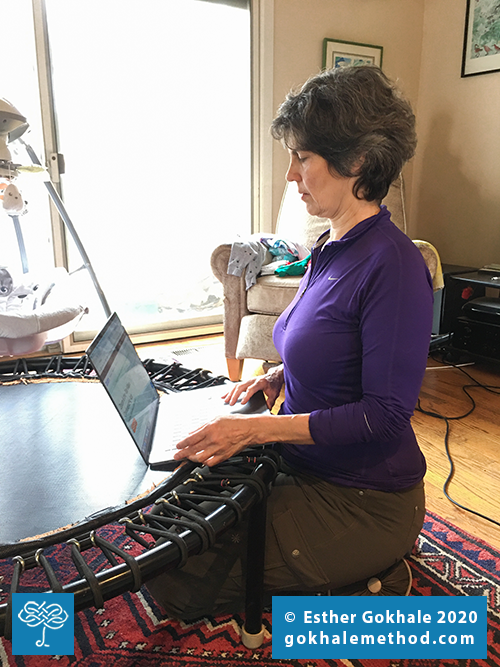
Floor-sitting with a wedge lets me comfortably use my Bellicon trampoline as a low desk.
How high should my monitor be?
Steve: Is the screen being 2 or 3 inches below eye level a problem? With my current desk height, I have to look slightly down at my display while writing. Should I be worried about the possibility of neck and back strain if I’m looking down that much and for that long?
EG: That sounds perfect, actually. Think hunter-gatherer: the line of vision would slant down since you have to be looking for animal tracks, signs of buried tubers, and watching where you step. Our bodies are perfectly capable of this behavior as they’ve been doing it for many millennia.
90-degree knees?
Steve: I’m curious about knee angle. I’ve heard that my knees should create a 90-degree angle while sitting. Is this true?
EG: There’s no research I know of that says this. People like even numbers and just make them up, even if they rarely exist in the complexity of nature and biology — parallel lines, 90-degree angles, etc. This reminds me for some reason of how rhino horns are supposed to be an aphrodisiac.
Humans are skilled at pattern recognition, which sometimes predisposes us to make conceptual leaps not grounded in fact when we see patterns that aren’t really there (i.e. rhino horns being thought of as an aphrodisiac). Part of the cultural baggage of having looked so strongly to Ancient Greece during the “Enlightenment” era of European history is a somewhat reductive expectation for symmetry and geometry, not only in the field of mathematics, but also in the human body. (More on that in another blog post.) In any case, worrying about human knees always being at a 90-degree angle while seated is not really a concern of mine. In fact, externally rotating the legs is a more constructive goal, and one among many other posture nuggets you can learn to achieve in our online posture coaching courses.
It’s also worth mentioning that, for seated desk work, the chair we painstakingly designed is both conducive to good posture and extremely durable. I’ve had mine for around 10 years and it’s still in great repair.

Modifying my laptop height with books, coming in close to the computer, and keeping my shoulders in a healthy position help make this seated desk arrangement gentle on the body, as well as sustainable. And with my decade-old Gokhale Pain-Free™ Chair, I can actually stretchsit while I work.
Keyboard placement: what’s the right distance?
Steve: How important is it that I be able to come in close to the keyboard?
EG: Very. Though your arms are certainly capable of reaching out to a more distant keyboard, this takes more muscular effort. If you have the choice, come in super close — the feeling wants to be almost like you're surrounded by your desk or as though you're in a cockpit. When the keyboard is further away, this can easily play into old habits of curving the upper back forward, craning the neck forward, or displacing the shoulders forward, all of which compromise the body.
Standing desks: what’s the best approach?
Steve: I want to fashion a standing workspace out of my new seated desk. I figure I’ll probably get an additional place-on-top appliance to make the desk work for standing as well as sitting.
EG: I use a simple wooden footstool on top of my massage table when I want a standing desk — I just place my laptop on the stool and work away.
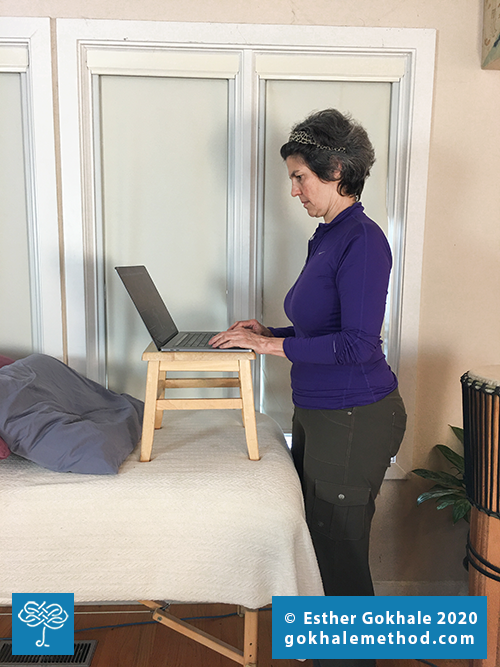
This simple footstool on top of my massage table is my preferred standing desk setup.
Sometimes my Congolese drum can be useful too, but it’s not really stable enough. Whatever you use doesn’t have to be formal — just a nice height.
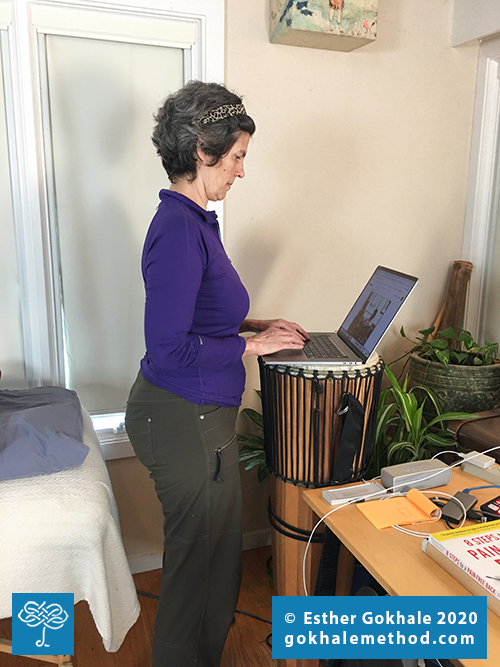
My Congolese drum is another option for a standing desk surface.
The home work space posts on the Twitter thread started by @julesforrest illustrate this nicely.

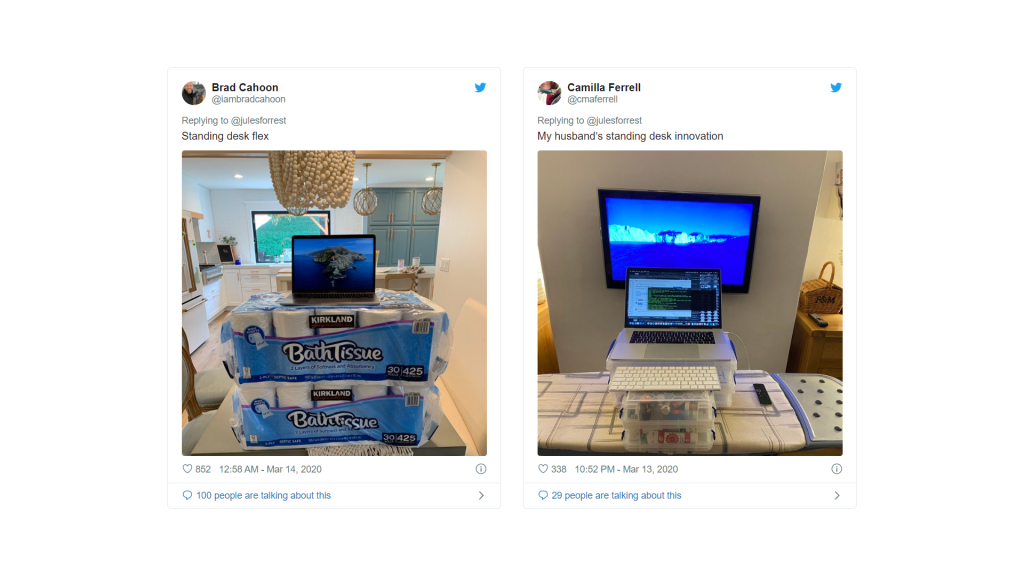
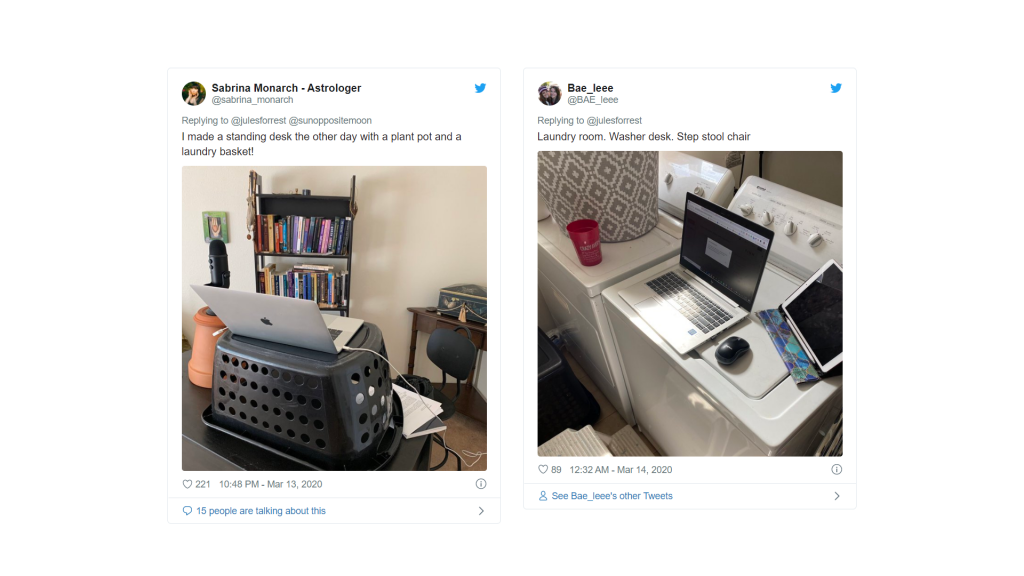 Whatever your creative desk arrangement, make sure you use healthy posture while standing — tallstanding comes to mind. Get creative and experiment: changing your work location and/or position can inject a fresh burst of energy into your day. Give it a try!
Whatever your creative desk arrangement, make sure you use healthy posture while standing — tallstanding comes to mind. Get creative and experiment: changing your work location and/or position can inject a fresh burst of energy into your day. Give it a try!

Comments
This is great info as always,
This is great info as always, thank you!
I was wondering about the arm rests which seem to be missing from all your examples and also from your chair. As much as I wanted to implement and adopt all the habits and advice from your book and posts I found it difficult and straining for the shoulders to use a keyboard for extended periods of time without any support for the arms.
I work in IT where you have to use a computer most of the time and also for a few hours at a time (trying to get more micro-breaks...).
What do you think / advice?
Thank you again for all the help you give us through this website!
Mihnea
I'm surprised no one
I'm surprised no one mentioned the kitchen counter for a standing desk. I use mine all the time, carrying my laptop there when I want to stand up.
Edwina
I use a massage cushion. I
I use a massage cushion. I relax for 10-15 minutes durin work day and bu the end of the day I feel great!
Add New Comment
Login to add commment
Login